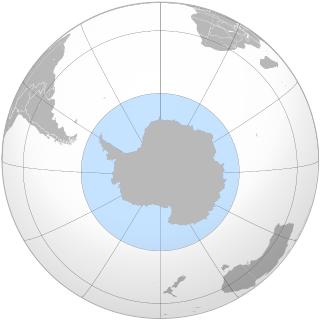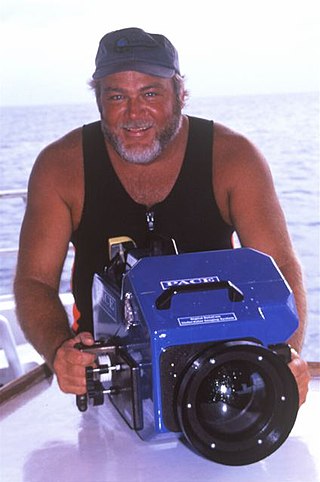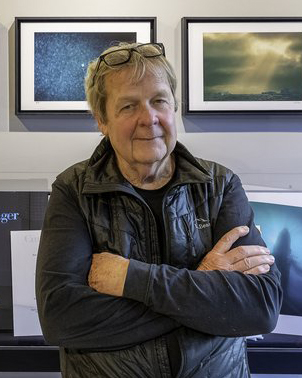
The Ross Sea is a deep bay of the Southern Ocean in Antarctica, between Victoria Land and Marie Byrd Land and within the Ross Embayment, and is the southernmost sea on Earth. It derives its name from the British explorer James Clark Ross who visited this area in 1841. To the west of the sea lies Ross Island and Victoria Land, to the east Roosevelt Island and Edward VII Peninsula in Marie Byrd Land, while the southernmost part is covered by the Ross Ice Shelf, and is about 200 miles (320 km) from the South Pole. Its boundaries and area have been defined by the New Zealand National Institute of Water and Atmospheric Research as having an area of 637,000 square kilometres (246,000 sq mi).

The leopard seal, also referred to as the sea leopard, is the second largest species of seal in the Antarctic. Its only natural predator is the orca. It feeds on a wide range of prey including cephalopods, other pinnipeds, krill, fish, and birds, particularly penguins. It is the only species in the genus Hydrurga. Its closest relatives are the Ross seal, the crabeater seal and the Weddell seal, which together are known as the tribe of Lobodontini seals. The name hydrurga means "water worker" and leptonyx is the Greek for "thin-clawed".

Sylvia Alice Earle is an American marine biologist, oceanographer, explorer, author, and lecturer. She has been a National Geographic explorer-in-residence since 1998. Earle was the first female chief scientist of the U.S. National Oceanic and Atmospheric Administration, and was named by Time Magazine as its first Hero for the Planet in 1998.

McMurdo Sound is a sound in Antarctica. It is the southernmost navigable body of water in the world, and is about 1,300 kilometres (810 mi) from the South Pole.

Kaikō was a remotely operated underwater vehicle (ROV) built by the Japan Agency for Marine-Earth Science and Technology (JAMSTEC) for exploration of the deep sea. Kaikō was the second of only five vessels ever to reach the bottom of the Challenger Deep, as of 2019. Between 1995 and 2003, this 10.6 ton unmanned submersible conducted more than 250 dives, collecting 350 biological species, some of which could prove to be useful in medical and industrial applications. On 29 May 2003, Kaikō was lost at sea off the coast of Shikoku Island during Typhoon Chan-Hom, when a secondary cable connecting it to its launcher at the ocean surface broke.
Ron Josiah Taylor, AM was a prominent Australian shark expert, as is his widow, Valerie Taylor. They were credited with being pioneers in several areas, including being the first people to film great white sharks without the protection of a cage. Their expertise has been called upon for films such as Jaws, Orca and Sky Pirates.

Brian Skerry is an American photojournalist and film producer specializing in marine life and ocean environments. Since 1998 he has been a contributing photographer for National Geographic magazine with more than 30 stories to his credit, including 6 covers. In 2021 Skerry won a Primetime Emmy Award for his role as producer in the miniseries, Secrets of the Whales.
The following outline is provided as an overview of and introduction to Oceanography.
James F. Cahill was one of the pioneers of scuba diving, in essence helping to create the sport and industry.

Guy Harvey is a Jamaican marine wildlife artist and conservationist. His depictions of sealife, especially of sportfish such as marlin, are popular with sportfishermen and have been reproduced in prints, posters, T-shirts, jewellery, clothing, and other consumer items. Harvey is also a very vocal and active advocate for marine conservation, having established the Guy Harvey Research Institute (GHRI) at Nova Southeastern University in Fort Lauderdale, Florida as well as the Guy Harvey Ocean Foundation, an organisation that funds scientific research and educational initiatives.

The Southern Ocean, also known as the Antarctic Ocean, comprises the southernmost waters of the world ocean, generally taken to be south of 60° S latitude and encircling Antarctica. With a size of 20,327,000 km2 (7,848,000 sq mi), it is regarded as the second-smallest of the five principal oceanic divisions: smaller than the Pacific, Atlantic, and Indian oceans but larger than the Arctic Ocean. Since the 1980s, the Southern Ocean has been subject to rapid climate change, which has led to changes in the marine ecosystem.

Bret Clifton Gilliam is a pioneering technical diver. He is most famous as the founder of the certification agency Technical Diving International, and as the one time holder of the world record for deep diving on air. He is also one of diving's most popular writers. Gilliam is the author or coauthor of 72 books, over 1500 feature magazine articles, and over 100 magazine cover photos. In his diving career he has logged over 19,000 dives since 1959.

The Phoenix Islands Protected Area (PIPA) is located in the Republic of Kiribati, an ocean nation in the central Pacific approximately midway between Australia and Hawaii. PIPA constitutes 11.34% of Kiribati's exclusive economic zone (EEZ), and with a size of 408,250 km2 (157,630 sq mi), it is one of the largest marine protected areas (MPA) and one of the largest protected areas of any type on Earth. The PIPA was also designated as the world's largest and deepest UNESCO World Heritage Site in 2010.
René Théophile "Phil" Nuytten, is a Canadian entrepreneur, deep-ocean explorer, scientist, inventor of the Newtsuit, and founder of Nuytco Research Ltd.
Les Kaufman is an evolutionary ecologist specializing in the biology and conservation of aquatic ecosystems. He has special expertise in coral reef biology, the evolution and ecology of tropical great lakes fishes, and ecosystem-based management of marine resources.
The NOGI Awards is an award presented annually by the Academy of Underwater Arts and Sciences (AUAS) to diving luminaries and is "considered the Oscar of the ocean world." Selection of recipients is based on their record of accomplishments and excellence in the diving world. NOGI awards are given out to world-class standouts of the diving community who have distinguished themselves and made a global impact on diving in one or more of four general categories: Science, Arts, Sports/Education, and Environment. A fifth NOGI is given for Distinguished Service.
Hillary Rika Hauser is an American photojournalist and environmental activist with a focus on the oceans — underwater diving adventure, politics, and conservation. In 2009, in recognition of her ocean environmental work as it relates to underwater diving, Hauser received the NOGI Award for Distinguished Service from the Academy of Underwater Arts and Sciences. In 2013 the Academy elected Hauser as president of its board of directors.

Jill Heinerth is a Canadian cave diver, underwater explorer, writer, photographer and film-maker. She has made TV series for PBS, National Geographic Channel and the BBC, consulted on movies for directors including James Cameron, written several books and produced documentaries including We Are Water and Ben's Vortex, about the disappearance of Ben McDaniel.

Valerie May Taylor AM is a conservationist, photographer and filmmaker, and an inaugural member of the diving hall-of-fame. With her husband Ron Taylor, she made documentaries about sharks, and filmed sequences for films including Jaws (1975).

Bill Curtsinger is an American photographer and writer who publishes on underwater photography and natural history subjects. Curtsinger has photographed thirty-five articles, including six cover stories for National Geographic as well as a cover story for Life. His photos have also appeared in Smithsonian, Natural History, various scientific journals and a number of books worldwide.













